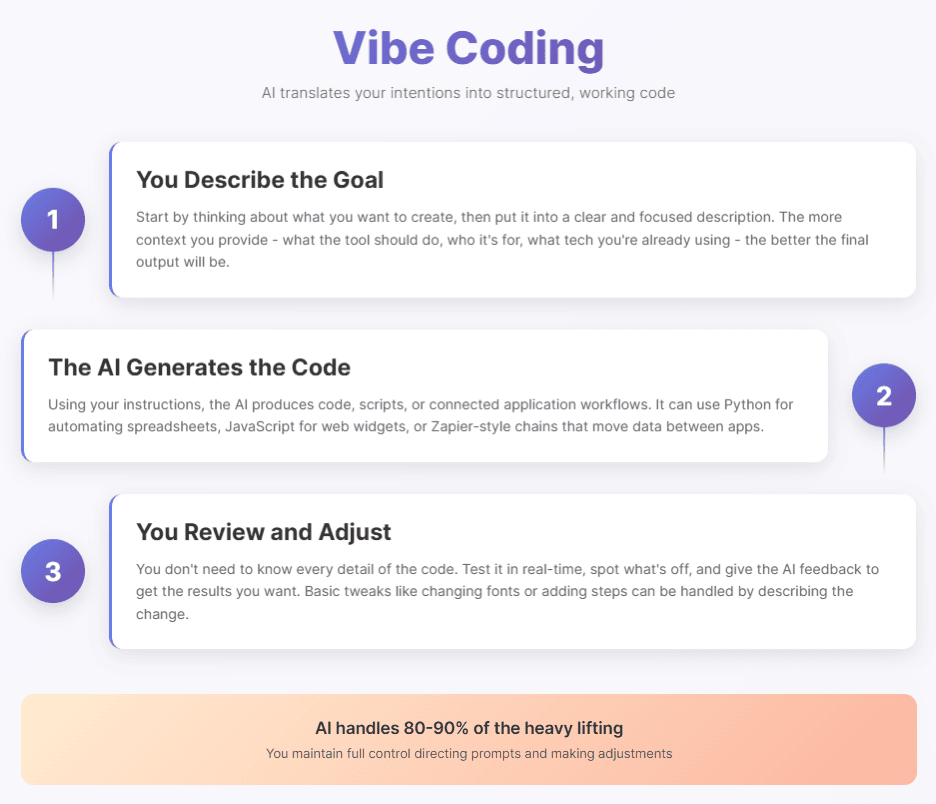Build What You Imagine Without a Single Semicolon
In AI, a new phrase is becoming the star: Vibe Coding. It’s not a formal programming language. Vibe Coding isn’t even really coding in the traditional sense. Now, you can simply tell AI what you want, in your own words, and let it write, structure, and even correct the code for you.
It is designing and creating with words. You set the vibe, the AI handles the syntax. Marketing teams are using it to automate reports, small business owners are building mini apps, and even seasoned developers are using it to seriously speed up their workflow.
The best part? You don’t need to spend time learning programming before you can start building things that actually work. No computer science degree required!
What Is Vibe Coding?
Vibe coding is a casual way of describing a very real shift in how people build software and automate workflows. Instead of writing every line of code yourself, you “set the vibe,” explain what you want in natural language, and let an AI tool generate the code, structure, or connections for you.
It’s much different than traditional programming. You used to have to learn a language’s syntax, write everything manually, and then debug… line-by-line. But at the same time it’s not quite the same as full no-code platforms like Wix or Squarespace. There you “drag and drop” pre-made elements to create. Vibe coding sits in the middle: You use your articulated ideas to guide AI, then you can tweak or expand on what it codes for you.
A typical vibe coding prompt could look like:
“Create a website form that will collect my customer’s feedback. Then save it to a Google Sheet, and then have it email me the results once a week on Thursdays.”
The AI builds the pieces, connects all the services, and hands gives you an app you can use immediately, or you can tweak it to perfection if you have more specific needs.
Vibe coding turns your ideas into testable working prototypes without the learning curve of old-school coding.

How It Works in Practice
Vibe coding works because AI has gotten really good at translating intention into structured, working code. The process is pretty straightforward once you see it in action.
1. You Describe the Goal
You start by thinking about what you want to create, then put it into clear and focused description. The more context you give: what the tool should do, who it’s for, what tech you are already using, the better the final output will be.
2. The AI Generates the Code or Workflow
Using your instructions, the AI produces code, scripts, or connected application workflows. It can use Python code for automating a spreadsheet, JavaScript for a web widget, or a Zapier-style chain of actions that move all this data between apps.
3. You Review and Adjust
You don’t need to know every, or any, detail of the code. You can still test it in real-time, spot what’s off, and give the AI feedback to really get the results you want. Even basic tweaks, like changing text fonts or adding a missing step, can be handled by describing the change instead of editing hundreds of lines of raw code.
Popular Vibe Coding Tools
- ChatGPT / Claude / Gemini: General-purpose AI that can write and explain code in multiple languages.
- GitHub Copilot / Replit Ghostwriter: AI coding assistants inside developer tools.
- Zapier / Make / IFTT: Low to no-code platforms with AI features for building apps and automations.
In most cases, AI handles 80-90% of the real heavy lifting. You still have full control directing the prompts and making adjustments.
Why It’s a Game-Changer
Until now, building even the simplest app or automation meant one of two things, learn to code or find (and pay) someone who can. Vibe coding changes that two choice system completely.
Cut the Learning Curve
You don’t need to memorize any syntax or understand a single programming concept before you start building. You can go from an idea to a working prototype, which used to takes days, in a single afternoon.
Opens Doors Without a Degree
Small business owners, freelancers, marketers, and educators are using vibe coding to create tools that used to be out of reach. They’re creating everything from automated scheduling systems to interactive learning apps for students.
Frees Up Developers
For bigger teams, vibe coding lets the non-technical members build their own useful tools instead of submitting a ticket to IT and waiting weeks. That frees up developers to focus on their more complex projects. It can empower everyone to be able to solve their own problems.
Builds AI Literacy
Even without coding skills, you’ll learn how AI tools think, what they can (and definitely can’t) do, and how to guide them to the best result. Because with AI these skills are becoming just as valuable as programming itself.
Ultimately, vibe coding is just lowering the barrier (if not wiping it away completely) so more people can create without getting stuck at the idea phase.
Vibe Coding’s Limitations and Pitfalls
Vibe coding sure is powerful, but it’s not mystical or magical. Understanding where it usually falls short can save you a lot of frustration.
Output Quality Depends on Input Quality
If your instructions are vague, the AI’s output will be too. “Make me a website” might produce something flashy but useless. Clear, detailed prompts make all the difference.
The “Black Box” Problem
You can for sure get a beautiful working code without fully understanding how it’s working. That’s fine for small tools, but it can end up being a risk if you need to maintain, update, or scale the app/project later.
Complex Logic Still Needs Oversight
AI can handle a lot, but specific and intricate business rules, industry regulations (although getting better), or performance optimization usually call for at least some manual coding skills.
Debugging Can Get Messy
When something doesn’t work (and that’s bound to happen), AI can help troubleshoot the issue, but you’ll still need quite a bit of patience to fully test and refine. Sometimes a developer is the less frustrating and fastest fix.
Vibe coding is used best for rapid prototyping, automating mindless repetitive tasks, and building small to medium-scale tools.
How to Start Vibe Coding Today (For Free or Cheap)
The best part of vibe coding is that you don’t need a big budget or months of studying to get started. Here’s a practical entry path that works for pretty much anyone:
Pick an Everyday Problem
Think of one annoying task, big or small, that you’d love to not do or even a simple tool you wish you had. The best “first projects” are ones you actually care about, like pulling sales data into a single sheet or sending automated follow-up emails.
Choose a Friendly AI Tool
For pure text-to-code, try ChatGPT or Claude. If you want code and an instant place to run it, CodeSandbox is a good starting-out pick. For automation, start with Zapier or Make‘s free tiers.
Give Clear Instructions
Vibe coding with AI works the best when you describe exactly what you want to it, with as many of the details you can. The more time you take to get your prompt right, the less time you’ll have to take tweaking what it gives you. If something is still off, explain the issue and the fix as clear as possible.
Learn Just Enough Syntax
You definitely don’t need to be a programmer, but knowing a few basics: like what a variable is, or how to change text in HTML, can really help you refine your AI-generated work a lot faster.
Share and Reuse
Post your progress and working builds in communities like Reddit’s r/NoCode community or a relevant Discord group like Tools for Thought. You’ll get new ideas, feedback, and sometimes even good code snippets you can adapt for your own.
Your first project goal shouldn’t be perfection, it’s just proof you can take an idea from your head to something that actually works. Everything after that is considered leveling up.
Career Impact and Future of Vibe Coding
Vibe coding is way more than a “tech fad,” it’s part of a major shift in how work is getting done. As AI-assisted tools become the standard, being able to “speak AI” and turn instructions into working code or automations will put you ahead of the competition.
Job Listings Already Ask for It
Some job descriptions now even mention “experience with AI-assisted coding tools…” like GitHub Copilot or ChatGPT. Even if you’re not applying to a job that calls for a full-on developer, being able to show you’ve actually built something useful with AI will set you apart.
A Competitive Edge for Non-Technical Roles
Marketing managers, operations leaders, mentors and educators, and small business owners that see you can automate your workflows will also see you can make a bigger impact with less resources. And in the best companies for diversity and inclusion that can lead to better pay or even a faster promotion.
Grow Alongside No- and Low-Code
The no- to low-code market is expanding fast, and AI is just making those tools more and more powerful. Vibe coding fits right in, blending creativity, problem-solving, and tech without requiring any programming skills. Learn and adapt to it early and you’ll have a much nicer transition when it becomes the norm.
Future-Proofing Your Career
As AI becomes the workplace standard, vibe coding could be the bridge skill between old-school or traditional jobs and AI-heavy workflows, making you more adaptable and much harder to replace.
FAQs
Do I need to know how to code to start vibe coding?
Not really at all. There are many AI tools that handle the heavy lifting, so you can start with plain and clear prompts. That said, picking up a few “coding basics” will make it easier to really fine-tune what the AI gives you.
Will vibe coding replace developers?
No. Not yet… It’s better to think of it as a shortcut for small to medium projects, or a way for non-developers to create without waiting on a tech team, for now. Complex systems will still need people with expertise.
What’s the best tool to try first?
That really depends on what your goal is. If you just want to automate something, try Zapier or Make. If you want AI to write and run code, try Claude or ChatGPT. Both are really good starting points.
How much time should I really spend learning this?
Honestly, you can get a real feel for vibe coding in a single afternoon. After that, just a few hours a week is enough to complete projects and level up your skills without burning out.
Is vibe coding just a trend?
The name might fade, but the concept isn’t going anywhere. AI-assisted building is only getting better, and knowing how to guide these tools will keep being valuable.




